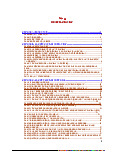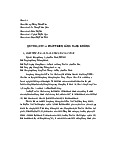



Preview text:
Gliding
Gliding is a recreational activity and competitive air sport in which pilots fly unpowered aircraft known as
gliders or sailplanes using naturally occurring currents of rising air in the atmosphere to remain airborne. The
word soaring is also used for the sport.
Gliding as a sport began in the 1920s. Initially the objective was to increase the duration of flights but soon
pilots attempted cross-country flights away from the place of launch. Improvements in aerodynamics and in
the understanding of weather phenomena have allowed greater distances at higher average speeds. Long
distances are now flown using any of the main sources of rising air: ridge lift, thermals and lee waves. When
conditions are favourable, experienced pilots can now fly hundreds of kilometres before returning to their
home airfields; occasionally flights of more than 1,000 kilometres (621 mi) are achieved.
Some competitive pilots fly in races around pre-defined courses. These gliding competitions test pilots' abilities
to make best use of local weather conditions as well as their flying skills. Local and national competitions are
organized in many countries, and there are biennial World Gliding Championships. Techniques to maximize a
glider's speed around the day's task in a competition have been developed, including the optimum speed to fly,
navigation using GPS and the carrying of water ballast. If the weather deteriorates pilots are sometimes unable
to complete a cross-country flight. Consequently, they may need to land elsewhere, perhaps in a field, but
motor glider pilots can avoid this by starting an engine.
Powered-aircraft and winches are the two most common means of launching gliders. These and other launch
methods require assistance and facilities such as airfields, tugs, and winches. These are usually provided by
gliding clubs who also train new pilots and maintain high safety standards. Although in most countries the
standards of safety of the pilots and the aircraft are the responsibility of governmental bodies, the clubs and
sometimes national gliding associations often have delegated authority. Soaring
Glider pilots can stay airborne for hours by flying through air that is ascending as fast or faster than the glider
itself is descending, thus gaining potential energy. The most commonly used sources of rising air are described in the following. Thermals
Thermals are streams of rising air that are formed on the ground through the warming of the surface by
sunlight. If the air contains enough moisture, the water will condense from the rising air and form cumulus
clouds. When the air has little moisture or when an inversion stops the warm air from rising high enough for
the moisture to condense, thermals do not create cumulus clouds. Without clouds or dust devils to mark the
thermals, thermals are not always associated with any feature on the ground. The pilot must then use both skill
and luck to find them using a sensitive vertical speed indicator called a variometer that quickly indicates climbs
and descents. Occasionally reliable thermals can be found in the exhaust gases from power stations or from fires.
Once a thermal is encountered, the pilot can fly in tight circles to keep the glider within the thermal, so gaining
altitude before flying towards the destination or to the next thermal. This is known as "thermalling".
Alternatively, glider pilots on cross-country flights may choose to 'dolphin'. This is when the pilot merely slows
down in rising air, and then speeds up again in the non-rising air, thus following an undulating flight path.
Dolphining allows the pilot to minimize the loss of height over great distances without spending time turning.
Climb rates depend on conditions, but rates of several meters per second are common and can be maximized
by gliders equipped with flaps. Thermals can also be formed in a line usually because of the wind or the terrain,
creating cloud streets. These can allow the pilot to fly straight while climbing in continuous lift.
As it requires rising heated air, thermalling is most effective in mid-latitudes from spring through late summer.
During winter the sun's heat can only create weak thermals, but ridge and wave lift can still be used during this period. Ridge Lift
A ridge soaring pilot uses upward air movements caused when the wind blows on to the sides of hills. It can
also be augmented by thermals when the slopes also face the sun. In places where a steady wind blows, a ridge
may allow virtually unlimited time aloft, although records for duration are no longer recognized because of the danger of exhaustion. Wave Lift
The powerfully rising and sinking air in mountain waves was discovered by glider pilot, Wolf Hirth, in 1933.
Gliders can sometimes climb in these waves to great altitudes, although pilots must use supplementary oxygen to avoid hypoxia.
This lift is often marked by long, stationary lenticular (lens-shaped) clouds lying perpendicular to the wind.
Mountain wave was used to set the current altitude record of 15,453 metres (50,699 ft) on 29 August 2006
over El Calafate, Argentina. The pilots, Steve Fossett and Einar Enevoldson, wore pressure suits. The current
world distance record of 3,008 kilometres (1,869 mi) by Klaus Ohlmann (set on 21 January 2003) was also
flown using mountain waves in South America.
A rare wave phenomenon is known as Morning Glory, a roll cloud producing strong lift. Pilots near Australia's
Gulf of Carpentaria make use of it in springtime. Launch Methods Aero Towing Winch Launching Auto Tow Bungee Launch Types of Gliders Gliding Terminology Abbrv. Description GPS Global Positioning System IMC
Instrument Meteorological Conditions km Kilometre kt Knot PPGL Private Pilot's Glider Licence QNH
Altimeter setting to obtain aerodrome elevation when on the ground ULM Ultra Light Motorised VFR Visual Flight Rules AD Aerodrome ATC Air Traffic Control ATR Air Traffic Rules BKN
Broken cloud (5 to 7 octas), followed by the height of the cloud base FEW
Few clouds (1 to 2 octas), followed by the height of the cloud base FH Flying hours Gliding Emergencies Critical Must be Checked by Engineer RB Rope Break. CL Canopy not latched. CC A control not connected. WD Wing drop (ground loop). AB Air brakes opening. Seriou Must be Checked by Operators s FP Flaps in wrong position. TP Tow plane power failure. TS Tow speed too slow or fast. DW Being towed too far downwind. CH Controls hooked up backwards. Modern Gliders




